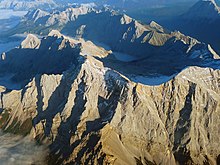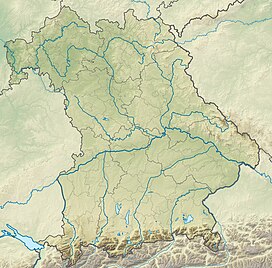Zugspitze
| Zugspitze | |
|---|---|
 | |
| Highest point | |
| Elevation | 2,962.06 m above sea level (NHN) (9,718.0 ft) |
| Prominence | 1,746 m ↓ Fernpass → Parseierspitze |
| Isolation | 24.6 km → Acherkogel |
| Listing | highest mountain in Germany, own post code: 82475 Zugspitze |
| Coordinates | 47°25′16″N 10°59′11″E / 47.4212167°N 10.9863139°E |
| Geography | |
| Parent range | Wetterstein Mountains, Eastern Alps |
| Geology | |
| Age of rock | Triassic |
| Type of rock | Wettersteinkalk[1] |
| Climbing | |
| First ascent | 27 August 1820 by Josef Naus, Johann Georg Tauschl, Messgehilfe Maier |
| Easiest route | Reintal Route |
The Zugspitze, at 2,962 metres above sea level, is the highest mountain in Germany and in the Wetterstein Mountains. It lies south of the town of Garmisch-Partenkirchen, and the border between Germany and Austria runs over its western summit. South of the mountain is the Zugspitzplatt, a high karst plateau with numerous caves. On the flanks of the Zugspitze there are three glaciers, including the two largest in Germany: the Northern Schneeferner with an area of 30.7 hectares and the Höllentalferner with a area of 24.7 hectares; the third is the Southern Schneeferner which covers 8.4 hectares.
The Zugspitze was first conquered on 27 August 1820 by Josef Naus, his survey assistant, Maier, and the mountain guide, Johann Georg Tauschl. Today there are standard routes to the summit: from the Höllental valley to the northeast; out of the Reintal valley to the southeast; and from the west over the Austrian Cirque (Österreichische Schneekar). One of the best known ridge routes in the Eastern Alps runs along the knife-edged Jubilee Arête (Jubiläumsgrat) to the summit, linking the Zugspitze, the Hochblassen and the Alpspitze. For mountaineers there is plenty of accommodation in the vicinity. On the western summit of the Zugspitze itself is the Münchner Haus and on the western slopes is the Wiener-Neustädter Hut.
Three cable cars run to the top of the Zugspitze. The first, the Tyrolean Zugspitze Cable Car, was built in 1926 and terminated on an arête below the summit before the terminus was moved to the actual summit in 1991. A rack railway, the Bavarian Zugspitze Railway, runs inside the northern flank of the mountain and ends on the Zugspitzplatt, from where another cable car takes passengers to the top. The rack railway and the Eibsee Cable Car, the third cableway, transport an average of 500,000 people to the summit each year. In winter, nine ski lifts cover the ski area on the Zugspitzplatt. The weather station, opened in 1900, and the research station of Schneefernerhaus are mainly used to conduct climate research.
Geography
Location and surrounding area


At 2,962 metres (9,718 ft) (eastern peak) the Zugspitze is the highest mountain of the Zugspitze massif. This height is referenced to the Amsterdamer Pegel and is given by the Bavarian State Office for Survey and Geoinformation.[2] The same height is recorded against the Trieste Gauge used in Austria, which is 27 cm lower. Originally the Zugspitze had three peaks: the east, middle and west summits (Ost-, Mittel- and Westgipfel). The only one that has remained in its original form is the east summit, which is also the only one that lies entirely on German territory. The middle summit fell victim to one of the cable car summit stations in 1930. In 1938 wurde the west summit was blown up to create a building site for a planned flight control room for the Wehrmacht. This was never built however. Originally the height of the west summit was given as 2,964 metres.[3]

The Zugspitze rises eleven kilometres southwest of Garmisch-Partenkirchen and just under six kilometres east of Ehrwald. The border between Germany and Austria runs over the west summit; thus the Zugspitze massif belongs to the German state of Bavaria and the Austrian state of Tyrol. The municipalities responsible for it are Grainau and Ehrwald. To the west the Zugspitze massif drops into the valley of the River Loisach, which flows around the massif towards the northeast in a curve whilst, in the east, the streams of Hammersbach and Partnach have their source. To the south the Gaistal valley and its river, the Leutascher Ache, separate the Wetterstein Mountains from the Mieming Chain. To the north at the foot of the Zugspitze is the lake of Eibsee. The next highest mountain in the area is the Acherkogel (3,008 m) in the Stubai Alps, which gives the Zugspitze an topographic isolation value of 24.6 kilometres. The reference point for the prominence is the Parseierspitze (3,036 m). In order to climb it from the Zugspitze, a descent to the Fern Pass (1,216 m) is required, so that the prominence is 1,746 metres.[4]
Zugspitzplatt

The Platt or Zugspitzplatt is a plateau below the summit of the Zugspitze to the south and southeast which lies at a height of between 2,000 and 2,650 metres. It is the head of the Reintal valley and has been shaped by a combination of weathering, karstification and glaciation. The area contains roches moutonnées, dolines and limestone pavements as a consequence of the ice ages. In addition moraines have been left behind by various glacial periods. At the beginning of the 19th century the Platt was completely covered by a glacier for the last time. Today 52 % of it consists of scree, 32 % of bedrock and 16 % of vegetation-covered soils, especially in the middle and lower areas.[5]
History
Shortly after World War II the US military took over the Schneefernerhaus (as the hotel at the top was then called) for the exclusive use of US military and civilian employees. Room rates, including meals, were US $1 per day. Ski lessons were available, taught by Austrians and Germans, at a cost of US $0.25 per hour.
The first recorded ascent to the summit was accomplished by a team of land surveyors on the 27th of August, 1820. The team was led by Lieutenant Josef Naus, who was accompanied by two men named Maier and G. Deutschl. However, local people had conquered the peak over 50 years earlier, according to a 1770 map discovered by the Alpenverein.[6]
On 7 January 1882 the first successful winter assault on the Zugspitze was accomplished by F. Kilger, H. and J. Zametzer and H. Schwaiger.
Tourism
Winter sports


For those wishing to reach the summit under their own power, various hiking and ski trails can also be followed to the top. Hiking to the top from the base takes between one and two days, or a few hours for the very fit. Food and lodging is available on some trails. In winter the Zugspitze is a popular skiing and snowboarding destination, with several slopes on both sides. The Zugspitzplatt is Germany's highest ski resort, and thus normally has sufficient snow throughout the winter.
Climbing
At the Zugspitze's summit is the Münchner Haus, a mountain hut (Alpenhütte), a facility built by the German Alpine Club (Deutscher Alpenverein). For more than a hundred years, the summit has also had a weather station, which nowadays also gathers data for the Global Atmosphere Watch.
Climbing up the Zugspitze can involve several routes. The large difference in elevation between Garmisch-Partenkirchen and the summit is 2 200 m, making the climb a challenge even for trained mountaineers.
On the German side, from Garmisch-Partenkirchen, climbers go either through the Höllental ("Valley of Hell") or the Reintal. The way through the Reintal is the easiest, but also the longest and takes 8 to 10 hours. This path goes through the Partnachklamm, a scenic gorge, then through the Reintal up to the Zugspitzplatt, a barren plateau. from there up to the summit. Climbers can stay for the night at two alpine huts, the "Reintalangerhütte" or the "Knorrhütte".
The more popular, but harder route is through the Höllental. It starts at Hammersbach near Garmisch, goes through the Höllentalklamm, a similar gorge up to the "Höllentalangerhütte", where one can take a meal or stay for the night. It then crosses the Höllentalferner, the remnants of a small glacier. After that it traverses a wall with the help of iron ladders and steps. Klettersteig equipment is recommended for that part. Over the Irmerscharte (a gap) it reaches the summit. This path will take 7 to 8 hours.
From the Austrian village of Ehrwald, there are also two variants. One goes straight through the Western Flank, which is the shortest route overall, but rather hard. It includes a via ferrata, and there is a hut called "Wiener Neustädter Hütte" by the Austrian Alpine Club. An easier path leads via the Ehrwalder Alm, across a small pass called "Gatterl", joining the Reintal path at the Knorrhütte.


References
- ^ Geologische Karte von Bayern mit Erläuterungen (1:500.000). Bayerisches Geologisches Landesamt, 1998.
- ^ Eva-Maria Greimel. "Zugspitze XXL:Deutschlands höchster Berg zeigt seine wahre Größe" (PDF). Presseinformation Bayerische Zugspitzbahn Bergbahn AG. Retrieved 8 August 2009.
- ^ Toni Hiebeler: Zugspitze – Von der Erstbesteigung bis heute. Mosaik, Munich, 1985, p. 25.
- ^ "Zugspitze". peakbagger.com. Retrieved 8 August 2009.
- ^ Hubert Engelbrecht. "Zugspitzplatt und Plattumrahmung". Retrieved 13 August 2009.
- ^ Harding, Luke (21 September 2006). "Locals had climbed peak before it was 'conquered'". London: The Guardian. Retrieved 20 April 2010.
External links
- Zugspitze on Distantpeak.com
- More comprehensive article about the Zugspitze in German Wikipedia
- Computer generated summit panoramas North South Index
- Bayerische Zugspitzbahn Bergbahn AG - Transportation to the mountain top and local webcams


